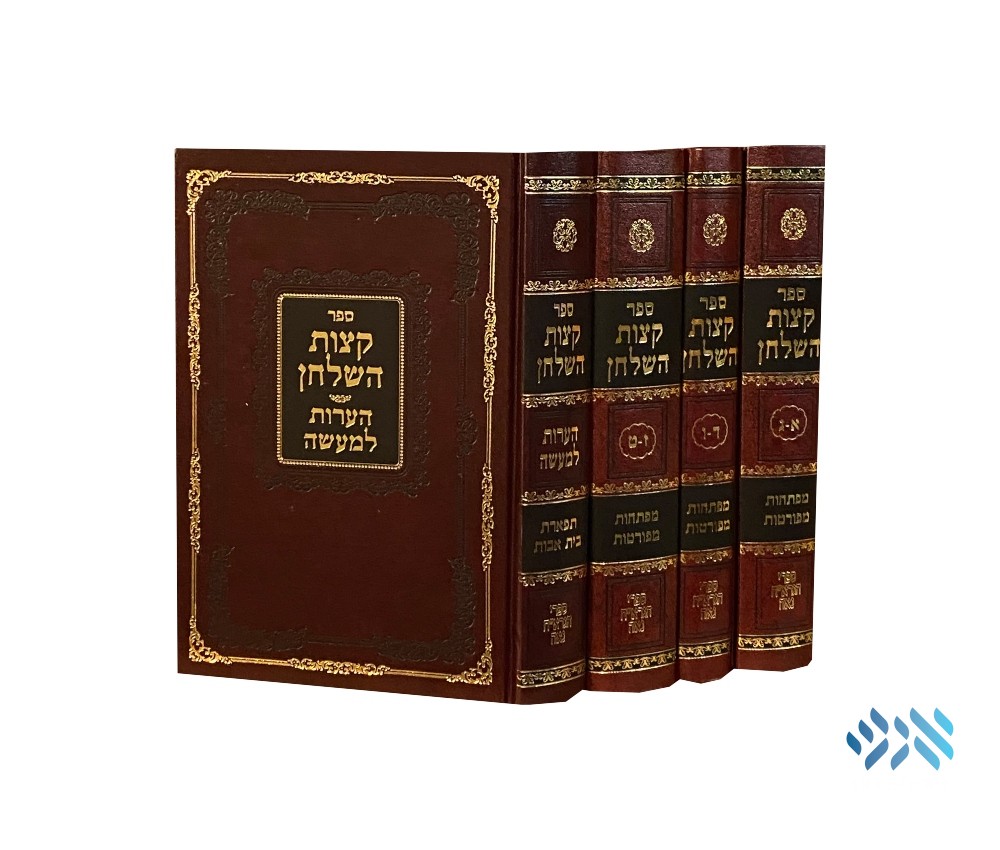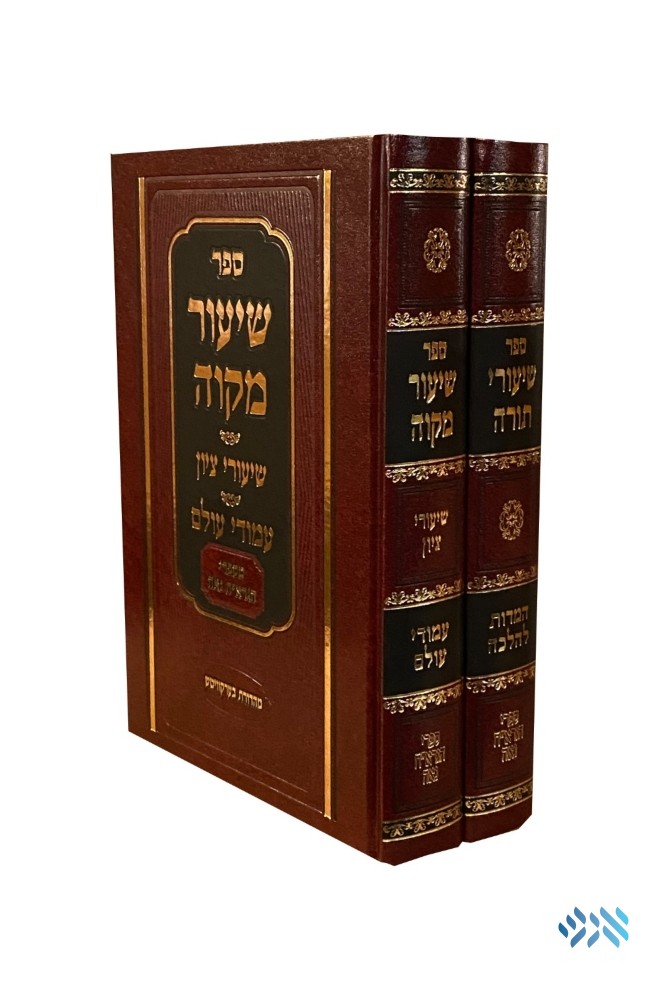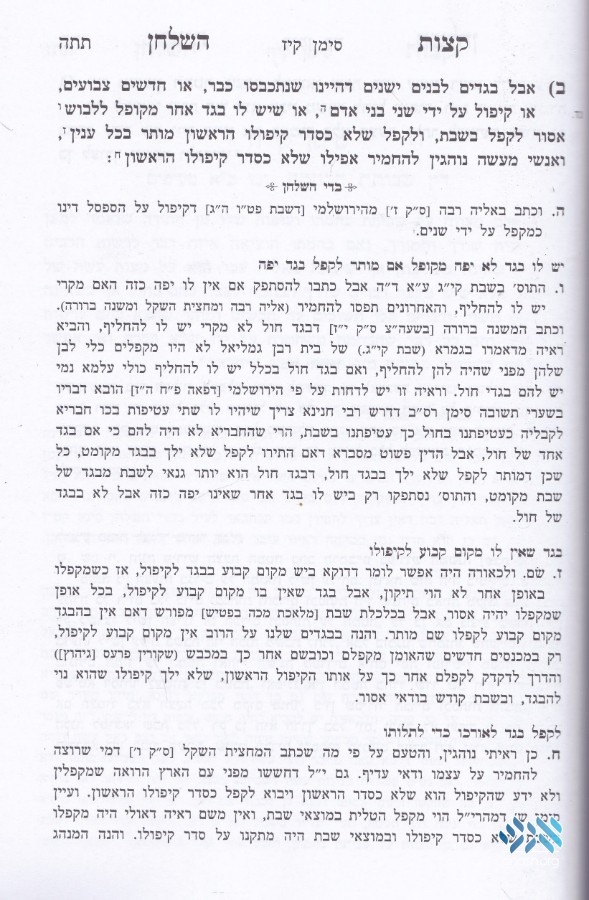ו׳ תמוז ה׳תשפ״א | June 15, 2021
These Classic Halacha Seforim Just Got a Lot Better
A Look Inside the Book: Ketzos Hashulchan and Shiurei Torah by Harav Avraham Chaim Naeh have been classics since they were first published over the years 5686-5714, and are a staple for Chabad chassidim. A new edition of these seforim with many welcome features makes the set a delight to use.

A Look Inside the Book: Ketzos Hashulchan and Shiurei Torah by Harav Avraham Chaim Naeh have been classics since they were first published over the years 5686-5714, and are a staple for Chabad chassidim. A new edition of these seforim with many welcome features makes the set a delight to use.
A Look Inside the Book is an Anash.org feature that takes a look at what’s new on the shelves of Seforim stores, and reviews recently printed seforim and books. The feature is presented in collaboration with SeforimDeals.com
By Shmuel Super
Ketzos Hashulchan 4 volumes
Shiurei Torah—Shiur Mikvah 2 volumes
Harav Avraham Chaim Naeh
New edition 5778 – 5780
Published by R. Avraham Chaim Naeh and R. Menachem Naeh
Introduction
Ketzos Hashulchan and Shiurei Torah by Harav Avraham Chaim Naeh have been classic halachah seforim since they were first published over the years 5686-5714. These seforim were reprinted many times since—in the original old typeset—but have been out of print for around a decade. Now, these popular classics are finally available again, and, for the first time, published in a completely new edition.
In this review, we will survey the contents of R. Chaim Naeh’s seforim, explore their unique function and style, and describe the improvements of the new edition.
To better understand R. Naeh’s life work, it is helpful to first briefly survey his life story. Born in Chevron in 5650 to a longtime Lubavitcher family, R. Naeh was sent by Rebbe Rashab to Samarkand at age 21, to serve as a Rov for the local Bucharian community.
Noting the lack of knowledge of basic halachos among the Bucharian youth, he wrote his first sefer titled Chanoch Lanaar, hilchos tefillin according to Sefardi custom—in Bucharian. This was R. Naeh’s first sefer, and it set the pattern for all the ones that followed—identifying a public lack of clarity in an area of practical halachic and immediately writing a sefer to address it.
R. Naeh spent a few months in Lubavitch in the court of the Rebbe Rashab, before returning to Eretz Yisrael where he married. During World War I, he was expelled from Eretz Yisrael by the Turks and fled to Egypt, where he promptly set up a Yeshivah for the exiles and locals. Here too, he identified a lack of clarity in the basic daily halachos, and wrote Shenos Chaim, a work on hilchos tefillah and the yamim tovim according to Sefardi custom with an Arabic translation.
Returning to Yerushalayim, R. Naeh began to work for the Beis Din of the Eidah Hachareidis as a secretary, in addition to other communal roles. Later, he was a founding member of the Badatz of Agudas Yisrael. R. Naeh passed away in 5714, at the relatively young age of 64.
The full story of R. Naeh’s fascinating life can be found in Nodah Beshiurim, by Shneur Zalman Berger.
Ketzos Hashulchan
Ketzos Hashulchan was originally published by R. Naeh in nine volumes over the course of almost 30 years, with the first volume appearing in 5686, and the final volume was published posthumously in 5714.
The set starts from the beginning of Orach Chaim with the morning halachos; goes through the halachos of tzitizis, tefillin, and davening; continues with hilchos berachos; and then all of the halachos of Shabbos. Subsequent additions combined the nine parts into three volumes, and the new edition keeps this structure.
The sefer is best defined by the renowned elder Chabad Rov, Harav Dovid Tzvi (Radatz) Chein in his haskamah to the first volume, written just a few months before his passing: a Kitzur Shulchan Aruch based on the Alter Rebbe.
The Alter Rebbe’s Shulchan Aruch follows the order of the mechaber’s Shulchan Aruch and its commentaries, summarizing the main opinions and their reasoning, and then rendering a ruling. R. Naeh writes in his introduction to Ketzos Hashulchan that not everyone has the time to study the Alter Rebbe’s Shulchan Aruch properly, and for this reason he has written an abridged version.
The methodology of Ketzos Hashulchan is to use the Alter Rebbe’s actual words as the base, re-edited and reorganized in order to present the practical halachos in the most practical manner.
To this end, Ketzos Hashulchan omits the variant opinions discussed by the Alter Rebbe, leaving only his final decision. Uncommon halachos are also omitted. However, unlike the Kitzur Shulchan Aruch and other abridged works of halachah, Ketzos Hashulchan does include the rationale for the halachos, a matter the Alter Rebbe placed strong emphasis on.
Importantly, on the not-infrequent occasions when the Alter Rebbe changed his mind in his Siddur, Ketzos Hashulchan only brings the final ruling given in the Siddur. The pesakim of the Tzemach Tzedek are also included, along with relevant minhagei Chabad.
To the base of the abridged words of the Alter Rebbe, R. Naeh adds some practical halachos found in later poskim. In his humility, whenever R. Naeh adds even a word of his own—as explanation or addressing a new matter—he encloses it in square brackets.
To make the halachos as clear as possible, R. Naeh also reorganizes them. The halachos are re-divided into a new structure of simanim, and within each siman the order of the halachos is also changed. While the Alter Rebbe and the mechaber’s Shulchan Aruch follow an order dictated by the internal logic of the halachic topics, R. Naeh’s order is dictated by practicality—presenting the halachos in the clearest and most user friendly structure.
For example, we will take the halachos of treating the sick on Shabbos. In the Alter Rebbe’s Shulchan Aruch, these halachos appear in one siman, divided into 55 lengthy se’ifim (siman 328). The order follows the flow of the internal logic of the sugyos, making it very difficult for the layman to extract practical guidance. In the Kitzur Shulchan Aruch there are only nine short se’ifim short on this topic (siman 92), with very few details.
Ketzos Hashulchan divides the halachos of treating the sick into five separate, smaller, simanim (134-138), and completely reorganizes the halachos to follow a more practical-oriented structure. The five simanim follow the order of of people that are sick but not in mortal danger (134), sick people in mortal danger (135), treatment of bodily wounds (136), definition of certain issues that constitute mortal danger according to halachah (137), and then some additional details about the treatment of specific issues that don’t pose a mortal danger (138).
Within the simanim themselves there is also a clear practical order: siman 134 begins by establishing five categories of non-endangered sick people and then proceeds to detail the halachos pertaining to each of them. In this way, the layman is able to learn the halachos and emerge with a clear and practical understanding of them.
Another noteworthy point regarding Ketzos Hashulchan is that it contains halachos that are missing from the Alter Rebbe’s Shulchan Aruch. The halachos pertaining to topics such as kerias haTorah, mincha and maariv, and beis haknesses, are all summarized based on the classic poskim, and in accordance with the rulings of the Alter Rebbe on these topics in other contexts and minhag Chabad.
The final volume of Ketzos Hashulchan includes a number of related kuntreisim published by the mechaber. Piskei Hasidur highlights and discusses all of the differences between the Alter Rebbe’s rulings in the Shulchan Aruch and Sidur, Kuntres Hasidur comments on apparent printing mistakes in the siddur, and Kuntres Hashulchan notes apparent printing mistakes in the Alter Rebbe’s Shulchan Aruch (most of these have been accepted and corrected in the new edition of the Alter Rebbe’s Shulchan Aruch).
Badei Hashulchan
Under the overall title of Ketzos Hashulchan, these seforim are actually comprised of two parts: the body of Ketzos Hashulchan containing halachos collected from the Alter Rebbe and other poskim as described above, and the footnotes titled Badei Hashulchan.
While the body of Ketzos Hashulchan expresses the author’s practical organizational skills, the extensive Badei Hashulchan footnotes express his incredible breadth of knowledge and analytical genius.
Badei Hashulchan footnotes the sources of the halachos stated in the Ketzos Hashulchan, discusses and analyzes their sources, and also applies the halachic principles to contemporary questions. These notes are very lengthy, especially in hilchos Shabbos, where one se’if is sometimes followed by multiple pages of detailed discussion.
R. Naeh’s uniquely practical mind can also be seen in the in-depth analyses of halachic theory. In Badei Hashulchan 125:20 R. Naeh discusses the halachos of borer [selecting, or sorting] on Shabbos, as they pertain to the practical scenario of looking for one’s coat within a pile of garments. Earlier poskim discussed the possible halachic problem sifting through the clothing entails, and some actually forbid doing so if one doesn’t know from the outset exactly where his coat is (see Mishnah Berurah 319:15, and Shevisas HaShabbos, borer 13:27).
In his discussion of this question, R. Naeh builds a halachic case for its permissibility. Then he brings an original proof for the correctness of his conclusion. The Mishnah (Sukkah 3:13) relates how people would fulfill the mitzvah of lulav and esrog on the first day of Yom Tov when it occurred on Shabbos, during the time of the Beis Hamikdash: everyone would bring their lulavim to shul before Shabbos, and in the morning they would identify their set and fulfill the mitzvah.
Thinking practically, R. Naeh writes that the lulavim must have been placed in a pile in the shul, and in order for a person to find their own—on the first day of Sukkos one may not use a borrowed lulav—they would have had to sift through the pile. Here R. Naeh finds proof for his earlier argument, that sifting through a pile to find one’s belongings is indeed permissible.
A very important feature of the Badei Hashulchan footnotes is the application of the halachos to contemporary questions. R. Naeh was a pioneer in this regard, the first posek to address many of these issues.
Returning to our earlier example of the halachos of treating the sick on Shabbos, Badei Hashulchan (end of siman 138) addresses many practical questions not found in the earlier poskim. Examples include taking medicine for a headache (allowed only if the person is bedridden), sleeping pills (allowed), using toothpaste (allowed, but it shouldn’t be placed on the toothbrush), and applying mosquito repellent lotion (allowed).
True to form, R. Naeh shows a full understanding of the practical dimensions of the contemporary questions he addresses, enabling him to not only apply the halachah to them, but also give guidance for how to solve the practical problems raised.
For example, in Badei Hashulchan 130:21 R. Naeh discusses the question of pouring water on concrete on Shabbos, showing complete familiarity with the actual process of hardening concrete. As a result, aside from stating that this is forbidden on Shabbos as a derivative of the melachah of losh (kneading), he is able to give practical advice for how a frum construction worker can avoid the need to do it on Shabbos.
The Rebbeim greatly appreciated and encouraged R. Naeh’s work explaining the Alter Rebbe’s rulings and making them accessible. The Friediker Rebbe sent a letter of blessing published at the beginning of volume 6, and the original edition of volume 7 has the Rebbe at the top of the list of contributors towards publication (see Nodah Beshiurim, p. 221).
R. Naeh maintained an ongoing correspondence with the Rebbe concerning matters of halachah and minhag, beginning in the years before the Rebbe’s nesius. The Rebbe praised R. Naeh’s passion for the study and dissemination of the Alter Rebbe’s halachic opinions and the careful and precise manner in which he approached it (Sichos Kodesh 5735, vol. p. 49; see also p. 496).
He’aros Lemaaseh
As part of his mission to spread the knowledge of practical halachah, R. Naeh wrote a column in Hamodia newspaper titled He’aros Lemaaseh, focusing on timely and relevant halachos. Rabbonim writing on halachah in newspapers was a novel concept at the time, but for R. Naeh it was just a natural extension of his life mission, to further awareness and observance of practical halachah.
These columns were first collected and published as a book in 5774, and this volume is now included in the new edition of the set of Ketzos Hashulchan. He’aros Lemaaseh addresses topics such as hilchos tefillah, yamim tovim, and shemitah, pointing out practical halachos that the public isn’t sufficiently aware of and rendering original rulings on new halachic questions of the time.
The Rebbe read these columns and sometimes sent R. Naeh comments on them. In one article R. Naeh writes that one of the gedolei hador asked him to call attention to the issue of people neglecting to answer amein to the berachah of hagomel, responding only with mi shegemalcha tov etc. This unnamed gadol was in fact the Rebbe, who called attention to this issue in a letter to R. Naeh (Igros Kodesh, vol. 4, p. 260).
The sefer of He’aros Lemaaseh also includes a kuntres on the topic of the time of alos hashachar, and a kuntres titled Tiferes Beis Avos, including teshuvos from R. Naeh’s ancestors and descendants.
The New Edition
The new edition of Ketzos Hashulchan contains a number of welcome features. Most obviously, the sefer has been fully retypset and now appears in a clear and readable font. In the old edition, the Badei Hashulchan appeared in long run on paragraphs, and in some of the volumes there is no division into paragraphs at all, making it very difficult to find a specific point or topic. The new edition breaks up the Badei Hashulchan into clearly divided paragraphs with headers summarizing the content, rendering it very user-friendly.
Miluim the author included at the end of later volumes are now inserted in the relevant places and indicated accordingly. The final siman of Ketzos Hashulchan in the original print was missing a few pages at the end, and these have now been published from the author’s ksav yad for the first time.
The original division into nine chalokim has now effectively been erased, with the pages of the seforim all numbered consecutively, and a table of contents for the entire volume appears at the beginning of each volume.
The final volume contains a number of helpful indexes. There is detailed table of contents for all of the major topics covered in the Ketzos Hashulchan and Badei Hashulchan (this should preferably have been included at the beginning of each volume), an alphabetic index for the topics, and a very helpful index according to the order of the Shulchan Aruch of the mechaber showing where the content of every se’if in the Shulchan Aruch and its commentaries—including the Mishnah Berurah—is discussed in the Ketzos Hashulchan and Badei Hashulchan.
One improvement that could have been made would have been to repunctuate the seforim. Punctuation standards have evolved greatly over the past 80 years and updating this would make the seforim a more fluent read.
Shiurei Torah
R. Chaim Naeh’s name is synonymous with shiurim, the halachic measurements he calculated. Over the ages, rishonim and achronim gave different measurements for the halachic shiurim, using weights and items common in their time and place. With the advent of standardized systems of measurements the need arose to translate the shiurim into these systems. R. Chaim Naeh was the pioneer in this field, and his shiurim remain the most commonly accepted.
Shiurei Torah and Shiurei Mikvah are the seforim in which R. Chaim Naeh built the case for his measurements. These fascinating seforim attest to the author’s incredible mastery of all the relevant Torah literature, as well as his talents in mathematics and geometry.
A proper review of these seforim, and the new edition of them, is beyond the scope of this article. These seforim are sold separately from the Ketzos Hashulchan, and the presentation of the new edition follows the same format, with much new material added.
Suggestion: An Abridged Ketzos Hashulchan
In his learned review of the original volume 7 of Ketzos Hashulchan, Harav Shlomo Yosef Zevin pointed out that the length and depth of the Badei Hashulchan footnotes hinders the goal of the sefer to serve as a kitzur of the Shulchan Aruch.
R. Zevin recommended that a separate edition be published including just the body of the Ketzos Hashulchan, so that those who wish should be able to comfortably use the sefer solely as a kitzur.
When this review was later published in Soferim Usoferim, R. Zevin wrote an addendum noting that the author has since passed away without implementing his recommendation, but he advises his son, a great talmid chacham in his own right, to publish such an edition. It is thus appropriate to continue to recommend the publication of an abridged edition, now addressed to the grandsons of R. Naeh, also fine talmidei chachamim.
In order to preserve the value of the practical and contemporary halachic issues addressed in the Badei Hashulchan it would be best to produce an abridged Piskei Badei Hashulchan, including just the final ruling with brief rationale, in the style of the Ketzos Hashulchan. In addition, it would be appropriate to add directives from Sefer Haminhagim, which was not yet published when the Ketzos Hashulchan originally appeared. The footnotes referencing sources for the Ketzos Hashulchan should also be included.
Such an abridged version of Ketzos Hashulchan, which should fit into a single volume, would be well suited for use in schools. Currently, halachah is usually learned in Chabad schools from the Kitzur Shulchan Aruch, using an edition including notes regarding the Alter Rebbe’s rulings and minhagei Chabad assembled by Harav Levi Bistritzky. Learning halachah from the Ketzos Hashulchan would offer the advantage of learning from the Alter Rebbe’s own (lightly edited) words, and also include more practical and contemporary halachos.
Conclusion
Ketzos Hashulchan is a classic work of halachah appropriate for all levels of learners. Schoolchildren will appreciate the clear and concise halachos. Bochurim and yungerleit studying halachah in depth will find the body of the Ketzos Hashulchan very useful as a chazarah aid, and will also enjoy the in-depth analysis of the Badei Hashulchan. Laymen will benefit from the practical presentation and the contemporary questions addressed.
The new edition of Ketzos Hashulchan is a delight to use. Even those that own the old edition should positively consider buying the new one for its many advantages.
Ketzos Hashulchan can be purchased here.
Shiurei Torah—Shiur Mikva can be purchased here.








We appreciate your feedback. If you have any additional information to contribute to this article, it will be added below.